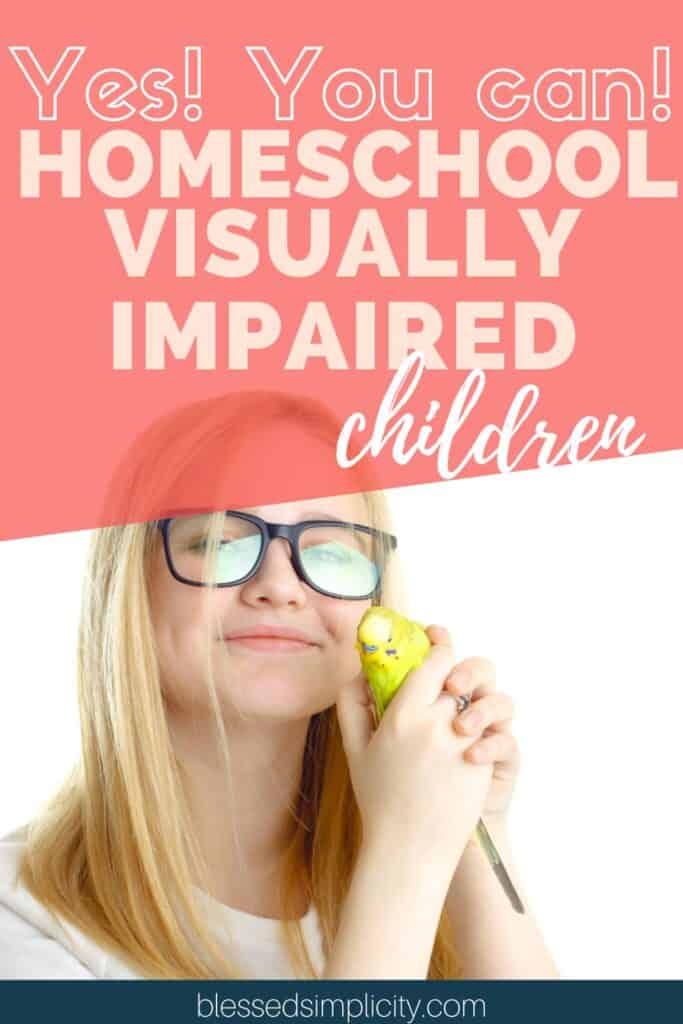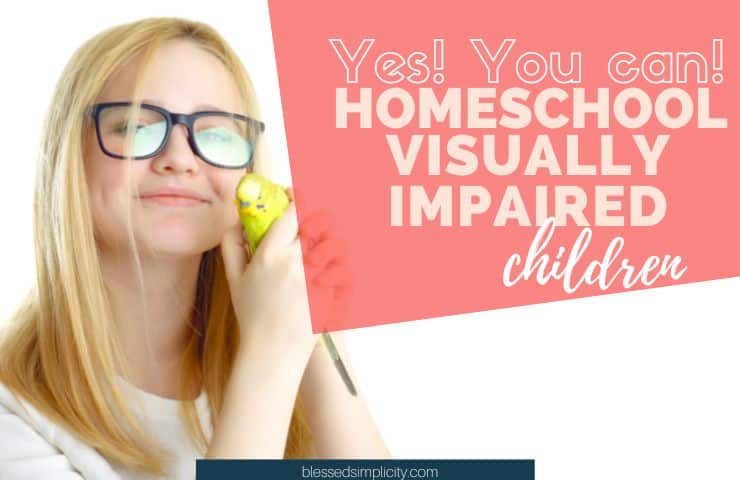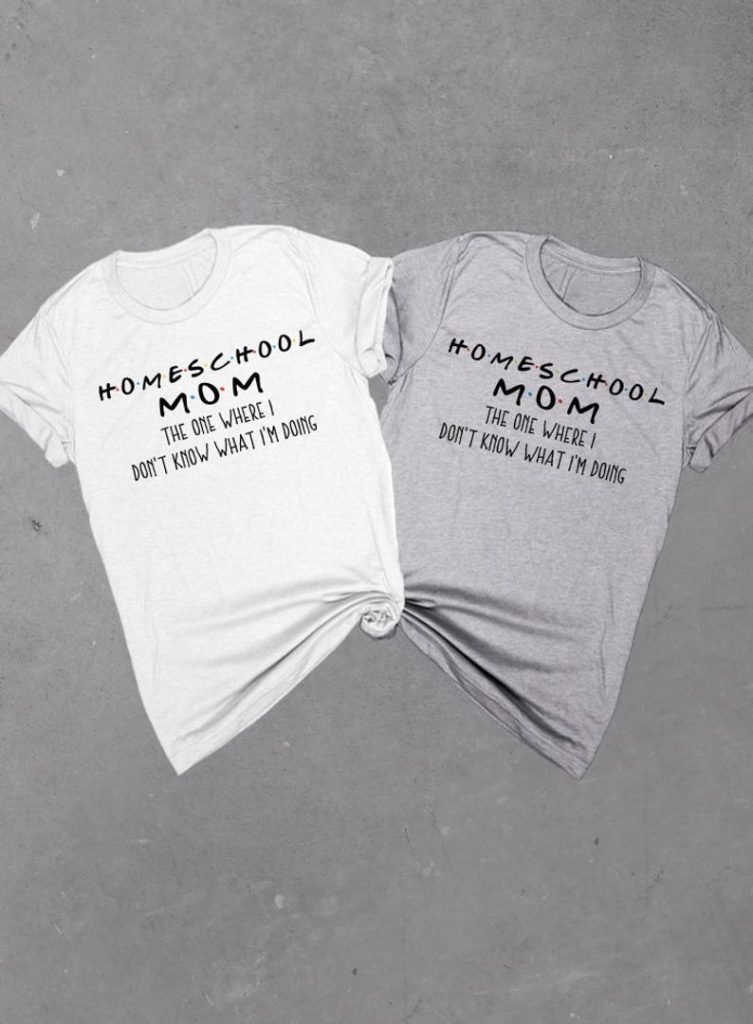Homeschooling a Visually Impaired Child
Yes. You can homeschool a visually impaired child or a blind child without a special degree or training? Not only can you do it, homeschooling can be an amazing gift for a blind or visually impaired child, and their parent.

*This post contains affiliate links. Please see full disclosure policy below.
Homeschooling a Visually Impaired Child
While homeschooling has become increasingly popular in recent years, there are still many questions surrounding the practice. For parents of visually impaired children, the idea of homeschooling can seem especially daunting. Parents worry about finding resources, making sure their child’s education is well rounded and complete, and managing everyday tasks like cooking and cleaning while also teaching their child?
These are all valid concerns, but with a little planning and preparation, homeschooling a blind or visually impaired child can be a rewarding experience for both parent and child. With the right support, you can give your child the gift of a personalized education that meets their unique needs. So if you’re considering homeschooling a visually impaired child, don’t let the challenges discourage you. Instead, use them as motivation to do your research and find the resources you need to ensure a successful homeschooling experience.
What are the benefits of homeschooling a visually impaired child?
If you choose to homeschool your blind or visually impaired child, you will be able to insure that your child’s educational needs are being met. You will be able to insure that he has access to the technology and media that he needs. You will also be there to insure that your child is learning and not being overlooked or left behind. Homeschooling is also an incredible bonding experience for families.
What are the challenges of homeschooling a blind or visually impaired child?
Homeschooling any child does not come without its challenges. Homeschooling a blind or visually impaired child, however, has some challenges unique to the situation, such as:
- Sighted parents who have never experienced visual impairment
- BVI curricula is not as readily available as traditional books and curricula
- Adaptations and accommodations will be required for the learning environment
- Parent’s may need to learn and teach a new language (Braille)
- Orientation and Mobility instruction may be required
- Teaching activities of daily living will be different
- Some local school districts may not be as cooperative in working with a homeschool family (if desired)
How do you create a homeschool curriculum for a visually impaired child?
There are many ways of creating a curriculum for any homeschooled child. There are pre packaged “all in one” curricula and also companies who specialize in certain subject areas like Apologia Sciences, Math U See, All About Learning (Reading and Spelling). There are some really great curriculum options out there to use with a visually impaired child. However, before you make a final selection, I suggest to get a learning media assessment performed for your child. This can be done by a Teacher of the Visually Impaired (TVI) or your child’s low vision team.
You may also consider using some non traditional mediums like lapbooks that you can assemble yourself. If you wonder what is a lapbook anyway? Just search online and you can find tons of resources.
Tips for Choosing Curriculum
When homeschooling a visually impaired child, you will need to make some adjustments to the curriculum and materials. Here are some tips:
- Choose materials that are age and developmentally appropriate.
- Make sure the materials are in a format that the child can use, such as Braille, large print, or audio.
- Use technology to your advantage. There are many software programs and apps that can be used by visually impaired children to help them learn.
- Be flexible. The homeschooling schedule and routine will likely need to be adjusted to accommodate the needs of the child.
- Get support. Connect with other homeschooling families, educators, and organizations that serve visually impaired children.
How do you know if your visually impaired child is ready for homeschooling?
There is no one-size-fits-all answer to this question, as each child is unique and will have different educational needs. However, there are some general guidelines you can follow to help you decide if homeschooling is the right choice for your child. Consider the following questions:
- Is your child at an age and, more importantly, stage of development that is appropriate for structured learning.
- Is your child interested in learning?
- Can your child attend to a task for 10-15 minutes?
- Is your child able to play independently for 15-20 minutes?
- Does your child have the motor skills required for “school” work?
Is it important that your child socialize with other visually impaired children?
The question of socialization is raised in regarding the idea of homeschooling no matter if the child has some special need or impairment or if the child is a neuro typical, traditional learning with no disabilities. There are varying opinions, so I will share my own with you. After nearly twenty years of homeschooling children of all kids, I think socialization happens naturally better outside of a traditional classroom setting. However, with my visually impaired daughter, I like for her to have interaction with other kids who wear glasses, use a white cane, and read braille. I think it helps her feel “normal.” However, she was perfectly fine before she started playing with other visually impaired kids.
What are some tips for teaching a visually impaired child at home?
Some homeschooling tips for parents of visually impaired children include:
- Finding support groups and networks for both the child and the parent. These can be local chapters of the National Organization for Parents of Blind Children, or even Facebook Groups for Blind homeschoolers. If you are a mom needing support, you are welcome to join my Fifteen Minutes for Mom facebook group where we coach weekly on topics relevant for all mothers.
- Learning as much as possible about visual impairments, including different types and treatments.
- Working with TVI do develop a learning plan for your child
- Incorporating a variety of tactile and visual aids into homeschooling materials and activities.
- Planning for accommodations such as extra time for tests, Braille materials, or large print books.
- Allowing the child to be as independent as possible and encouraging self-advocacy skills.
- Keeping a positive attitude and remaining flexible.
What are some ways to adapt learning materials for a visually impaired child?
There are a few ways to adapt homeschooling materials for visually impaired children. One way is to use Braille textbooks and worksheets. You can also use raised-line drawings or tactile diagrams to help explain concepts. Additionally, you can use audio recordings of texts instead of printed versions. Finally, it is important to provide plenty of opportunities for your child to explore and touch objects to learn about their properties and textures.
How often should you have your child assessed by a low vision professional?
You should follow your doctor’s advice for follow up ophthalmology appointments and check in with your low vision team at least annually or any time you notice any new issues with your child’s vision.
What are some resources for parents of homeschooled children with visual impairments?
These are just some of the questions that may come up when considering homeschooling a visually impaired child. While it is not an easy decision, it can be a rewarding one for both parent and child. With the right preparation and support, homeschooling can provide a visually impaired child with the individualized attention and tailor-made curriculum they need to thrive.
More Special Needs Posts
- Non Candy Stocking Stuffers for Kids with Special Needs
- How to Use a Worry Board with Kids
- Can you Homeschool a Medically Complex Child?
- Care of a Visually Impaired Child
Other Homeschool Posts
- Can you Homeschool a Foster Child
- Self Care Activities for Homeschool Moms
- Multiple Grade Homeschool Schedule
- Tips for Homeschool Dads
Free Printable Homeschool Weekly Assignment Calendar








